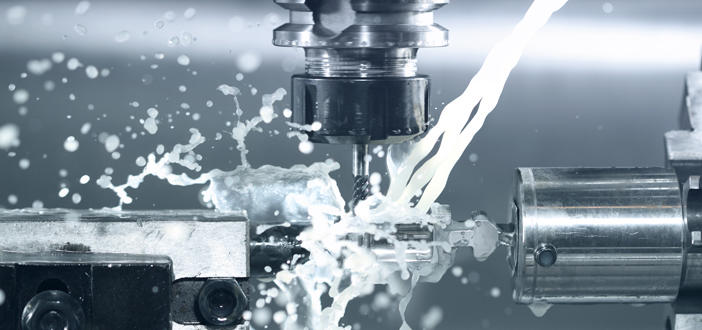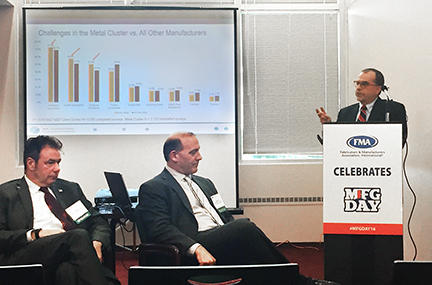Manufacturing Innovation Blog
Powered by the Manufacturing Extension Partnership

This guest blog post by Mark Schmit originally appeared on tradeology, the official blog of ITA.
As we close out Manufacturing Month, SelectUSA is featuring a two-part guest blog from members of the Federal Interagency Investment Working Group (IIWG). The IIWG is responsible for coordinating activities across federal agencies that promote investment.
Mark Schmit is National Accounts Manager for the National Institute of Standards and Technology’s Manufacturing Extension Partnership.
U.S. Secretary of Commerce Penny Pritzker was in Portland, Oregon at a Makers Gone Pro Event. Secretary Pritzker spoke to recent high school graduates pursuing technical careers and joined 100 students at the Lam Research Facility, the world’s second-largest semiconductor equipment manufacturer, emphasizing that by 2024, America’s economy will need to fill 2.2 million openings for production workers; half a million openings for engineers; and an untold number of openings for jobs in new, emerging occupations.
I was fortunate to be invited to attend How Manufacturing Drives the Economy, an event hosted by the Fabricators & Manufacturers Association, International (FMA) in Rockford, Illinois. Expert panelists highlighted the significant role manufacturing plays in bolstering America’s economy and the critical need to ensure that the sector remains a positive force.
Each panelist asserted that Manufacturing Day (MFG Day) – the 5th iteration was held on October 7th – exemplifies the importance of manufacturing. Thousands of manufacturers hosted students, teachers, parents, job seekers and community leaders at open houses, plant tours and educational sessions to showcase modern manufacturing technology and the attractive jobs that are available. It was (and still is) a chance for students to see innovative, impactful, durable and diverse career options. MFG Day can also help current students understand how to apply their studies in math and science to those careers. It dispels old, negative myths and stereotypes about manufacturing through highlighting the shift from a labor-intense environment to one of high-tech robotics and computers.
Stephen Gold, President and CEO of the Manufacturers Alliance for Productivity and Innovation, explained that the manufacturing value chain is far bigger than we think, since official government statistics only measure the value of the upstream supply chain and only include goods sold to final demand. But the downstream chain, from sales to transport to aftermarket services – significantly multiplies this impact.

Scott Mayer, Chairman and CEO of QPS Employment Group, noted that baby boomers are retiring at a high rate, and a new generation of manufacturing workers is needed. However, filling this gap continues to be a challenge, due in part to the fact that there is not enough recognition that the sector supports many good, well-paid, middle-class jobs. Mayer pointed to a need for more “grassroots” efforts involving parents and educators alike to make sure high school students know they have choices beyond traditional four-year degrees. Indeed, many young people may be better suited to skilled trades.
Dr. Chris Kuehl, managing partner at Armada Corporate Intelligence and FMA economic analyst, looked at the significance of U.S. manufacturing from a global perspective. “The manufacturing sector is the dominant player in U.S. exports, particularly with heavy machinery and other capital goods,” he said, “and the U.S. is more export dependent than people realize; it accounts for 14 percent of GDP, almost matching export-driven Japan at its 14.7 percent of GDP. What most people don’t recognize is that the U.S. accounts for 30 percent of all global manufacturing by value. China accounts for only 10 percent.”
The event was, for me, eye-opening and inspirational. On the return trip to O’Hare International Airport I had time to reflect on all that I heard and how it all fits together. Resting my head against the window as we rolled east on I-90, I saw the many of the metal working companies that Kenneth Voytek talked about earlier. Many of those companies had an American flag outside their facilities, but it was also obvious that some of those companies represented vital international investment in our country: Amada in Schaumburg, IL is a Japanese company; Bystronic in Elgin, IL is Swiss-owned company; Mazak also in Elgin, IL is Japanese; and Trumpf in Hoffman Estates, IL, is German.
The metal cluster along I-90 in Illinois is grand on an international scale, and manufacturing companies from all over the world want to establish a presence there. They want to be part of the local manufacturing ecosystem and do business in the United States. Which all begs the question...
Where were you on Manufacturing Day 2016? And even more importantly – where will you be next year?
Follow SelectUSA and MEP on Twitter and join the conversation at #MFGmonth.
About the author
Related Posts
Comments
- Reply


